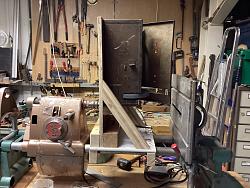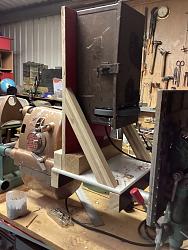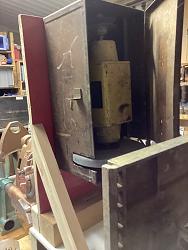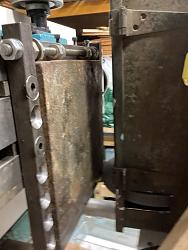I have a plate 9” square, 3/4” thick, rough, concave and perhaps to be cut into 3 parts, and then use it to make smoothing planes. I don’t know whether it is cast iron or steel. But I don’t fancy filing it flat. I saw on HMT a rig for an angle grinder. A very good idea! I could not produce an accurate rig like that and don’t have the materials, but thought of mounting a bench grinder on to my Shopsmith.
This is in our workshop, which is really for repairing furniture for residents in need, so, being a commercial property, the grinder has to be fully guarded, per regulations. So an old salvaged steel toolbox, happily the right size for the grinder, had a slot cut, then mounted on a stand,as shown, which slides along the Shopsmith’s bars, and the headstock can be used to advance it, and lock it. I brought my compound table from home and mounted it on the Shopsmith’s table, and made a pair of bars to secure the plate.
This shows the first traverse.
After all that, it became rather tedious to continue for long. It’s not a priority. Also, only about 4” of the surface can be ground at a setting. It is apparent that the surface is not wholly free from blemishes. Probably the workholding needs set screws to lock onto the plate. Needing the bench for other jobs, I dismantled the Shopsmith and put the components away, as before. It can be put together again. Also, you may observe that the Shopsmith’s lower structure is missing. It’s mounted on a softwood base, which is very unsatisfactory, and has now been discarded in favour of high density fibreboard, which hopefully is fully flat.



 LinkBack URL
LinkBack URL About LinkBacks
About LinkBacks






 Reply With Quote
Reply With Quote




Bookmarks